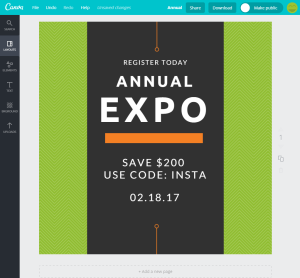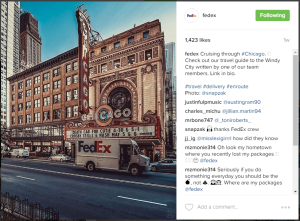Instagram is Gaining Popularity as a Marketing Tool for B2B and Nonprofits
What began as a little-known mobile photo-sharing app in 2010 has grown into a prominent social network with 300 million active daily users. While Instagram gained popularity as a way to easily share photos with friends and followers on other social networks it has become so much more. Now, companies of all sizes are using it to engage with customers and highlight the personality behind their brands. Taking a cue from these business-to-consumer marketers, organizations are now using it to reach other businesses and nonprofits are using it to enhance their image.
Before adding Instagram into the marketing mix, it’s important for an organization to understand how it works, why it should be used and how it fits into its overall marketing and content strategy. It’s not a good idea to start using Instagram just because everyone else is. There should be a purpose behind it, and everything posted should adhere to a company’s branding standards for consistency.
Instagram 101 for Marketers
Hashtags & Filters
For those who don’t know, people post photos and short videos on Instagram and use hashtags to label content so it can be found, and possibly shared, by others. A hashtag is a word or phrase preceded by the pound sign (#) that is used to identify a specific topic – think #instagramformarketers. Up to 30 hashtags can be used, which gives the content a better chance of being found. Different filters can also be applied to the photos in order to create different effects and moods.
Location Tags
Before an image is posted a location tag can be added. This is helpful if posting a picture of corporate headquarters or a special event. Locations are searchable so marketers can do reconnaissance to see who is nearby and then interact with other local companies or users.
Content & Captions
Content can include photos, short videos, snippets of infographics and other images. It’s best to use high-quality photos, which can be taken very easily on today’s smartphones. One of the most valuable features is the caption, the area beneath a photo where a company can include additional information. Live links aren’t allowed in this area so if one of the goals is to drive traffic to the website or blog, the organization will need to use the caption to direct users to their bio/profile in order to access the link. Captions cut off after the first few lines of text in the feed, so the most relevant information must come first.
In addition to photos, compelling images can be easily created with little or no design experience using free design tools like Canva. Here is an example of a simple, yet informative, graphic.
Infographics – visual representations of data that tell a story – are too large to appear in a post but they are a great way to provide industry information or tips. By sharing this type of content, followers may see an organization as a thought leader or industry expert. Savvy marketers could create a snippet of the infographics and post that, adding information that directs viewers to their profile description for more information.
The Value of Instagram to Marketers
Smart marketers who use Instagram for Business-to-Consumer (B2C) or Business-to-Business (B2B) marketing know how to tell a visual story that entertains, educates or inspires their audience. While showcasing their brand or organization they are connecting to people in an effective, yet authentic way. B2C marketers have a bit more flexibility in how they engage customers on this platform. They can hold contests asking their followers to submit photos of themselves with the brand or at their establishment, and they can even offer special coupons and discount codes through the app, only visible to their followers. These trackable tactics are a fun and effective way to boost engagement and increase ROI.
One company that does it well is FedEx, the multinational package courier.
See more posts from FedEx on Instagram.
B2B marketers, on the other hand, face more of a challenge when it comes to leveraging Instagram’s popularity. One of the biggest hurdles they face is trying to establish a coherent visual brand identity for a company that may offer a service instead of an actual product. They can try to overcome this by providing a behind-the-scenes look at the company or by posting content that shows how they connect to clients in a positive way. B2B marketers can also use Instagram as an opportunity to grab someone’s attention no matter what time they are using it. By providing informative and enlightening content an organization may stand out as one with similar values that could be a future business partner.
Specifically, Instagram can be used by B2B marketers to:
• Increase brand awareness and create a personal experience with it
• Foster relationships with current or potential customers
• Promote products and services, employees and special events
• Showcase what is special or unique about an organization
• Provide a behind-the-scenes look at the company and its culture
• Present industry insights, tips and thought leadership content
• Share company news and also create a feeling of community
• Chronicle the company’s growth through the years
• Highlight milestones, awards and other accolades
Nonprofits Can Also Benefit
Nonprofits can benefit from using Instagram the same way businesses do – to increase awareness of their organization, engage followers and build lasting relationships. Marketers in nonprofits or trade associations can use it to share photos of their employees and volunteers in action, provide a behind-the-scenes look at events and crowdsource images from followers and supporters. They can even include a call to action for a fundraiser or campaign. Remember, links aren’t live in the feed, but can be included in the bio area – just don’t forget to use the caption to let users know where to find any featured links referenced in the post.
Nonprofits with limited marketing resources may view participating on Instagram as another task for their already full plate. It is important to seriously consider the time and resource investment required before moving forward because once the decision is made it’s necessary to post and engage with followers consistently. The payoff could be huge as those followers could end up being some of the group’s biggest supporters.
One nonprofit organization that uses its Instagram account to its fullest potential is Doctors without Borders.
See more posts from Doctors Without Borders on Instagram.
Regardless of whether a marketer works at a for-profit company or at a nonprofit, Instagram is a valuable tool that can help an organization engage with its audience and build lasting relationships. With business acumen and a heart for storytelling, anything is possible.
Curious why you don’t see McKinley Marketing Partners on Instagram? Well, we are practicing what we preach and thoughtfully preparing a place for Instagram within our content marketing strategy. We’ll be sure to let you know when we make our Insta debut!




